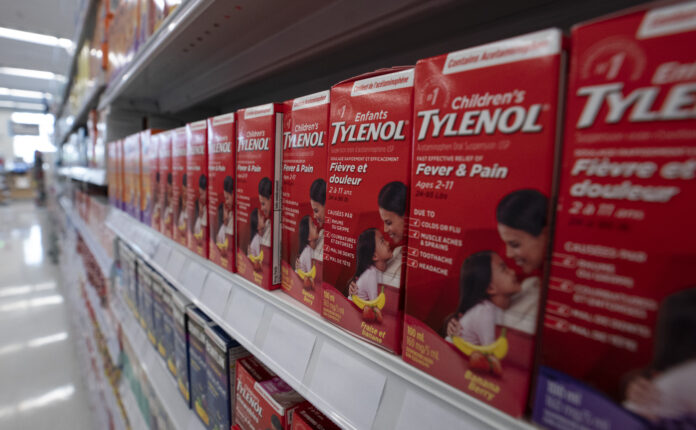Imported children’s pain and fever products will begin to appear on Canadian shelves next week, Health Canada confirmed on Friday.
The development comes as Canadian families have been grappling with a shortage of children’s pain medication, with unprecedented demand for children’s acetaminophen and ibuprofen emptying shelves across the country, according to Health Canada.
Manufacturers of these drugs in Canada have said they have increased production by 30 per cent, but demand continues to outstrip supply.
“We’ve now received and approved three proposals to import foreign product and supply has started to enter the country,” confirmed Health Canada’s senior medical advisor, Dr. Supriya Sharma.
“After next week, more than one million bottles of product will have entered Canada to supply hospitals, community pharmacies and retailers, and medications will start appearing on store shelves starting early next week.”
The announcement comes as Canada grapples with three separate surges in viruses.
Cases of COVID-19, respiratory syncytial virus (RSV) and an early onset of the flu season have posed a significant challenge for children’s hospitals across Canada, which have been swamped with children suffering from respiratory illnesses.
5:50
Additional Kids Cold/Flu Medication Coming to Canada
In order to stave off the worst impacts of the children’s pain medication shortage, Health Canada has been working secure foreign supplies.
On Monday, Health Minister Jean-Yves Duclos announced Health Canada had secured children’s pain medication shipments “equivalent to months of normal supply,” in addition to ramping up domestic production of these products.
Trending Now
Canada makes 16 new jobs eligible for permanent residence, including nurse aides
Hundreds of Twitter employees set to leave, offices close after Musk’s ultimatum
Last month, Health Canada approved the exceptional importation of ibuprofen from the United States and acetaminophen from Australia to supply hospitals in Canada amid the shortages.
The newly procured foreign pain products hitting the country’s shelves might not be from brands Canadians are familiar with. Because of that, Health Canada has included information alongside the drugs in order to ensure people know what they’re buying.
“If you see product that might be a little bit unfamiliar to you, a little bit different, there will be information including tear sheets, QR codes, and identifiers for the product that’s foreign product,” Sharma said.
She acknowledged that the ongoing shortages have been “very challenging for parents and caregivers, as well as our health-care system.”
“While drug shortages continue to make headlines, we are working tirelessly behind the scenes to end these shortages,” Sharma said.
“It’ll take time but things will get better as we start to see the results of increased production of Canadian acetaminophen and ibuprofen products supplemented by the foreign flow of products into the country.”
It’s not only children’s medications that are flying off of shelves.
Canadians have been impacted by worsening supply problems of over-the-counter and prescription drugs, with industry experts saying there is a growing list of medications that are running low or out of stock, from children’s allergy medication, adult cough and cold syrups to eye drops and even some oral antibiotics.
1:49
Children’s Hospital sees huge uptick in young patients early in flu season
When pressed on the widespread drug shortages, Sharma said the problem is “global” and has been an issue over the last 10 to 15 years.
“What we see with drug shortages is they can be different from country to country, depending on the supply situation and the demand situation,” she added, noting that the United States is feeling some “tightness” in its supply as well.
However, Canada is currently facing a “perfect storm” of issues leading to our widespread shortages.
“We had increased demand at a time where we did not typically see that increased demand, and then that’s the time that the companies would normally be replenishing stocks and then moving forward to get ready for the fall and the winter season,” Sharm explained.
“So they didn’t have the opportunity to do that, and then there was another increase in demand. So that seems to be a bit unique to Canada, in terms of that late push in summer and so that’s probably why we’re feeling it a bit more.”
— with files from Global News’ Teresa Wright and Aya Al-Hakim
© 2022 Global News, a division of Corus Entertainment Inc.



